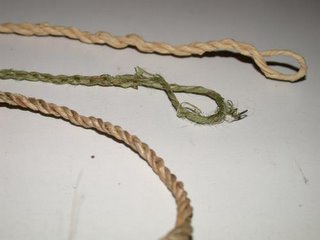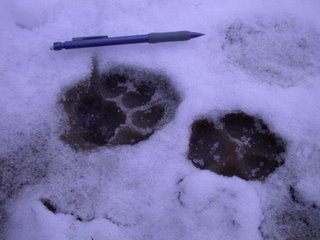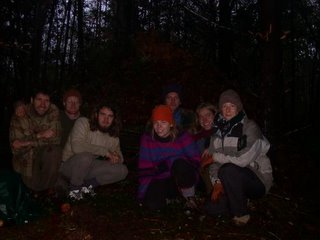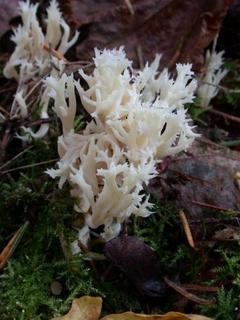
Today I will relate a story from a field trip to the Oregon sand dunes our class took a couple of weeks ago:
Early on in the trip one of our fellow students warned us about holes in the dunes from trees that had been engulfed by the sand long ago and since rotted out. While out exploring the dunes for tracks my group happened upon such a hole (probably around 10 inches across) and of course wondered how deep it was. After one of the original discoverers of the hole managed to get her whole leg down it, it was my turn being the longest legged in the group. When my leg didn't reach the bottom we tied some line to a water bottle and dropped it down. We were astounded when the 25 or so feet of that setup didn't land on anything. How could we stop at such a mystery? But what was left to do? Clothes! Most of us had some extra clothes as the day had warmed up since when we started early in the morning. So we tied shirts, bandanas, and jackets on to the end of the line, about 50 feet long now. It was a bit more difficult to judge if we hit bottom now, with all the weight of the clothes and the drag of them against the walls of the hole, but it definitely seemed that our make shift line went all the way down without grounding yet again. We pulled it back up and were about to give up and move on when somebody decided that we could drum up a few more clothes and make another go of it. I ended up tying on my t-shirt, bandana, and wool pants on this time, all of the extra additions made it around 75 feet. This time there was some question as to whether we had reached bottom. The person feeding the line down thought it had stopped, to demonstrate he lifted some of the line back out of the hole and dropped it only have it to continue quickly on dragging more of the pile in behind it (in retrospect, it is possible that it was at the bottom and that it was just the weight of the line that provided the momentum). So, once again we had the whole line in the hole without discernably hitting bottom. Having wasted enough time we decided to give up on figuring it out for the time being. As one of the other students was pulling up the line he started tugging a little without anything coming up "It's stuck". Now everyone's tenses up a little bit. Having the longest arms, I figure I might as well reach down in as far as I can and try and get it to come up. There was a stretchy shirt in there that was making things a little more difficult, but finally the line came free and I pulled the rest of it out. Or at least the rest of it that was above the knot that came loose. There were gasps and "No way!"s of astonishment, then a lot of laughter at what had happened. Only the instructor and one of the apprentices avoided losing anything to the hole, while one person lost a couple of shirts, a belt, and a bandana. I won't say whose knot it was that came apart, but I did end up with a bandana on the free end of the line and a shirt on the lost end of the lind (and fortunately my pants were safely out as well).
Early the next morning I went back with Matt to try and fish the clothes out. Someone donated some fish hooks to the cause and we used the line for tying things onto the van. We got to the hole (probably between a half mile and a mile away from camp) and I realized that the fish hooks were in my other jacket. So we jogged back to camp and I got the hooks and we headed back out to the hole. We tied up a bag of sand to weight the line down and arranged the hooks so they would hang beneath the bag. Not too surprisingly we didn't have any luck, though the clothes were stuck only about 30 feet down now. We figured that there was probably a decent layer of sand that had fallen in ontop of the clothes by now and something pretty substantial would be necessary to pierce the sand and grab the clothes.
Lacking appropriate retrieval tools we just resigned ourselves to having lost a bunch of clothes in exchange for a story. As a post script, the next day we were split up into different groups and on our way back at the end of the day I came back by with this group. Following the comment of one of the instructors on hearing the previous day's story we dropped matches and other burnables down the hole and watched excitedly as they swirled down out of sight. As it turns out, we weren't the first group to have done so, the instructors were wondering around together and had also come by the hole and dropped matches down before us.
I guess the moral of the story is, if you find a hole in the ground and want to see how far down it goes, get your stuff tied on as far back in the line as possible.
On an unrelated note, I finally managed to get a fire going in the "wild" using gathered materials and a lighter. This time I used hemlock twigs which I noticed got noticeably skinnier than the twigs I had been trying with before, so between that and going with the bigger is better method suggested in the last post I succeeded.
 I made the top cord with some arts and crafts grass that the instructors gave us to practice with, the second cord is out of a stalk of nettle I processed and the third is a triple reverse wrap using strands of cattail. I was able to break the cattail cord with a fairly strong pull. Pulling as hard as I could, I was unable to break the grass or the nettle cord, though with two of us pulling pretty hard we managed to break the nettle (we didn't try that with the grass).
I made the top cord with some arts and crafts grass that the instructors gave us to practice with, the second cord is out of a stalk of nettle I processed and the third is a triple reverse wrap using strands of cattail. I was able to break the cattail cord with a fairly strong pull. Pulling as hard as I could, I was unable to break the grass or the nettle cord, though with two of us pulling pretty hard we managed to break the nettle (we didn't try that with the grass). The top/left track is from the cougar that I was wrote about on the first. The bottom/right track is from the dog we were out with (a medium-large mutt). Though the picture isn't great for details, I can clearly see two of the major cougar vs. dog differentiators and can sort of see two others.
The top/left track is from the cougar that I was wrote about on the first. The bottom/right track is from the dog we were out with (a medium-large mutt). Though the picture isn't great for details, I can clearly see two of the major cougar vs. dog differentiators and can sort of see two others.





